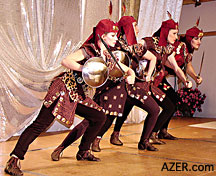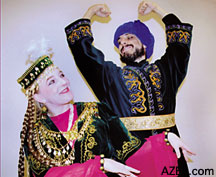|

Spring 2005 (13.1)
Pages
24-27
Nizami's "Seven Beauties"
Ancient Wisdom for the New Millennium
by
Laurel Victoria Gray
  Left: Laurel Victoria Gray Left: Laurel Victoria Gray
Written
in 1197, "Seven Beauties" ("Haft Paykar"
in the original Persian, and "Yeddi Gozal" in Azeri)
tells of the adventures of Bahram Gur, a prince destined to become
the ruler of the world. Nizami, the creator of this epic poem,
was born in Ganja, a town in Azerbaijan where he spent his entire
life. Today Nizami
is celebrated as a national poet throughout Azerbaijan, as well as in Iran
since the poem was written in Persian, the court language of
the day throughout the region.
In Seven Beauties, the young warrior Bahram Gur enters a mysterious,
locked room to discover the portraits of seven beautiful princesses,
each from a different land. When he wins a kingdom and achieves
great wealth and power, he remembers the maidens and summons
each of them, commissioning the architect Shideh to build seven
domed structures - one for each bride.
Shideh designs each of the domed structures, or "gonbasian",
to be astrologically linked with a specific planet, color and
day of the week. After two years, the buildings were ready, and
the king sent for the princesses.
Bahram Gur then visits each bride on her day of the week, dressing
with care in her signature colors. Each maiden tells the king
a tale, an engaging story containing a moral lesson. Thus Bahram
Gur progresses from Saturday to Friday, from black to white,
from darkness to illumination. When he finally emerges from the
palace of the Persian Princess of the White Dome, it is the first
day of Spring - Novruz - the beginning of the New Year.
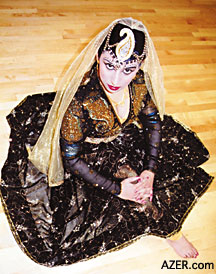  Left: The Indian Princess of the Black Dome,
portrayed by Monica Ullagadi, uses Kathak dance story to teach
the moral lesson of Patience. Left: The Indian Princess of the Black Dome,
portrayed by Monica Ullagadi, uses Kathak dance story to teach
the moral lesson of Patience.
My first
encounter with Nizami's hero Bahram Gur came while researching
Persian miniature paintings at the Metropolitan Museum of Art.
The theme of the legendary king visiting each of his seven princesses
was a favorite subject for Eastern artists, and the paintings
were ornamented with such exquisite detail of architecture and
dress that they transport the viewer into another world. Later,
I discovered the ballet Seven Beauties with an evocative score
by the famous Azerbaijani composer Gara Garayev written in 1952.
On more than one occasion my dance mentor, People's Artist of
Uzbekistan Qizlarhon Dustmuhamedova, suggested that I consider
the theme of Seven Beauties for a new dance piece. In the past,
the Uzbek ensemble "Bakhor" had used the concept as
a way for seven dancers each to have a solo in a different regional
style. I found myself strangely repulsed by the idea, even though
it would provide a charming way to spotlight the talents of the
dancers in my own professional group, the Silk Road Dance Company,
which performs dances from Central Asia and the Caucasus.
Frankly, the idea of glorifying a monarch who had seven wives
troubled me. My own Mormon great-grandfather had been a polygamist
and my great-grandmother had suffered because of this - their
private lives becoming the subject of newspaper stories in Utah.
But then I came up with the happy notion of simply omitting Bahram
Gur altogether and keeping the focus on the women. Having removed
the offending ruler from the concept, I comfortably began to
delve into the poem.
At first, Haft Paykar seemed like a fairy tale, brimming with
magical beings, beautiful maidens, and splendid treasures. Then,
slowly, Nizami's philosophical depth and sophistication revealed
itself. The poem contains layer upon layer of nuance and symbolism.
Below: 1. Slav Princess of
the Red Dome inspired by recent excavation of Amazon graves in
the Russian steppes. The dance of this princess, portrayed by
Joanne Giaquinta, revesals a marital spirit. 2. Slav Princess
of the Red Dome - Joanne Giaquinta - a marital dance with Kevin
Ryan.
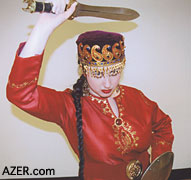 |
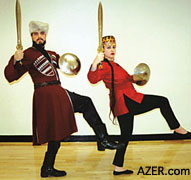 |
Seven Beauties has become a literary classic in both the East
and West - an erotic allegory about the quest for human perfection
steeped in numerology, geometry, astrology and color symbolism.
Not only does each of the seven princesses come from a different
country, or "clime", but also each is associated with
a different color, planet and virtue. "Seven" has long
been a sacred number, especially in the ancient Middle East.
It resonates on many levels: seven colors of the rainbow, seven
chakras (energy centers) of the human body, and seven planets
- known in medieval times as the Moon, Mercury, Venus, Mars,
the Sun, Jupiter and Saturn.
It soon became apparent to me that the original tale of these
seven princesses had often been trivialized; Bahram Gur had somehow
morphed into stereotypical Hollywood sultan with his slave girls.
Seven Beauties actually celebrates ethnic diversity, extols the
beauty of other cultures and praises the wisdom of women. The
marriages of Bahram Gur echo the ancient pre-Islamic ritual of
the Sacred Marriage between the King and the land.
Seven Virtues
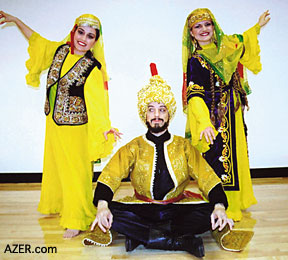  Left: Turkish (Rum) Princess
of the Yellow Dome Demet Jabbar, right and her handmaiden Sema
Muslu share a sunny dance with Kevin Ryan.Each of the seven maidens tells a tale
to her bridegroom that imparts a specific moral lesson. From
these wise women, the hero learns Patience, Truth, Faith, Passion,
Serenity, Fairness and Devotion to God. Since Bahram Gur is destined
to become Ruler of the World, he must learn these lessons in
order to govern wisely. The king's spiritual journey is a reminder
that only through self-knowledge and self-mastery can humans
find perfection. Left: Turkish (Rum) Princess
of the Yellow Dome Demet Jabbar, right and her handmaiden Sema
Muslu share a sunny dance with Kevin Ryan.Each of the seven maidens tells a tale
to her bridegroom that imparts a specific moral lesson. From
these wise women, the hero learns Patience, Truth, Faith, Passion,
Serenity, Fairness and Devotion to God. Since Bahram Gur is destined
to become Ruler of the World, he must learn these lessons in
order to govern wisely. The king's spiritual journey is a reminder
that only through self-knowledge and self-mastery can humans
find perfection.
Rather than exclude Bahram Gur from the stage production, it
became crucial to highlight his role as spiritual pilgrim. The
king is transformed by his interaction with the Princesses; he
sends to the far reaches of the known world to bring them and
the knowledge of other lands to his court. When, at the end of
each episode, Bahram Gur embraces a princess, he also embraces
her culture, her traditions, her teachings. According to Moroccan
sociologist Fatima Mernissa, the practice of women giving moral
instruction to princes was well established in the Islamic world;
Nizami reflects this tradition by using the Princesses to teach
the King.
Staging Seven Beauties
Originally,
I submitted a proposal for Seven Beauties to the 2004 Kennedy
Center Local Dance Commissioning Project competition but did
not expect it to be accepted; I had just won the $7,000 award
in 2003 for my ancient Egyptian production, Egypta. Still, I
felt it was somehow important to express my concept on paper,
to shape it into a more substantial form.
Above: 1. Dancers depict the
Amazons, part of the scene from the Slav Princess of the Red
Dome. 2.Khorasm Princess of the Green Dome - Cindy Connelly Ryan
- performs an authentic Khorasm dance from Uzbekistan, winning
the admiration of Bahram Gur - Kevin Ryan.
When Seven Beauties
was not chosen, I did not give up the idea but kept talking about
it. I noticed that when I began to repeat Nizami's tale, listeners
became enraptured. Such is the power of story telling. On an
impulse, I approached Christel Stevens, Performing Arts Specialist
with the Maryland-National Capital Park and Planning Commission
(MNCPPC). Armed with examples of the miniature paintings and
costume design, I sat in her office and began to tell the tale
of Bahram Gur and the Seven Beauties. Stevens immediately recognized
the potential of the work and scheduled its premiere in the Washington,
D.C. area for April 2, 2005, at the 3rd World Dance Showcase
with a special theme of "Dancing in Islamic Lands".
Choreographic Challenges
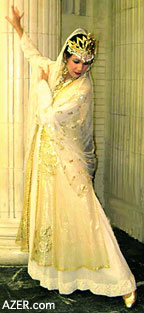  Left:
The Persian
Princess of the White Dome is linked to the planet Venus. The
Persian Princess is represented by Parastoo Ghodsi. Left:
The Persian
Princess of the White Dome is linked to the planet Venus. The
Persian Princess is represented by Parastoo Ghodsi.
Now that we
were all committed to the production of Haft Paykar, I had to
address the choreographic issues. Unlike ballet interpretations
of the Seven Beauties, my interpretation uses traditional music
and movement from each of the princesses' land of origin. I wanted
each maiden to "speak" in her native language, to dance
in her national style.
This meant that each princess and her handmaidens not only had
to master a distinct dance style, but that their costumes had
to reflect a specific ethnicity as well as match Nizami's original
color scheme. Over 60 costumes needed to be created since each
Princess was attended by handmaidens and Bahram Gur also had
to be properly attired for each scene. Much more difficult, the
abstract virtues of each of the Princess' tales needed to find
expression in dance.
The more I worked with the material of Seven Beauties, the more
I came to appreciate Nizami's genius, the depth of his thought
and intent behind every detail. Even elements that seemed strange
or out of place eventually showed their meaning upon analysis.
For example, the Indian Princess is linked to the Black Dome.
Yet Indian dress is so vibrantly colorful; how could I dress
my Indian Princess in black? It was unthinkable. What was Nizami
thinking by this choice? But this first princess is linked to
the planet Saturn. Her day is Saturday; and her color, black,
represents the void from which all is born. It is through her
that Bahram Gur begins his initiation.
The Princess of the Yellow Dome teaches the value of Honesty
to Bahram Gur. Nizami perfectly links this virtue with the princess'
planet, the Sun. In sunlight there are no shadows or secrets.
Everything is out in the open. Or consider that the color Green,
long associated with Islam, perfectly matches the moral lesson
of Faith, just as passion is tied to the color Red, and serenity
to Blue.
Choosing Music
It took over 18 months for me to find just the right music for
each maiden - music that not only reflected her land of origin,
but also expressed her character. For the Moroccan piece, I was
able to arrange for a Master Class with North African dance specialist
Amel Tafsout. Since this dance needed to reflect serenity, I
selected Moroccan Sufi music with a text by the mystic poet Ibn
al-Arabi, who was a contemporary of Nizami.
Discovering this music was quite coincidental: I feel I was guided
to it. The Princess and the handmaidens of the Blue Dome perform
a dance inspired by the Sufi ritual of Zikr, a spiritual practice,
which truly leads to a sense of inner peace.
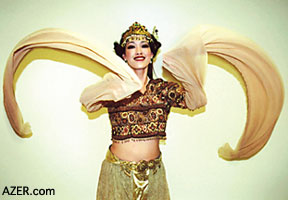  Left:
Chinese
Princess of th Sandal Dome. Cynthia Lin performs a Taiwanese
dance inspired by depiction of the Celestial Apasaras depicted
in the cave paintings in Dunhuang, China. Left:
Chinese
Princess of th Sandal Dome. Cynthia Lin performs a Taiwanese
dance inspired by depiction of the Celestial Apasaras depicted
in the cave paintings in Dunhuang, China.
Classical Indian
dance artist Jayantee Paine assisted me in the creation of the
North Indian style piece of the Princess of the Black Dome, "daughter
of the Indian Rajah". The maiden's tale focuses on Patience
or, more specifically, to mastering one's physical desires. I
was thrilled to discover a haunting "ghazal" that was
ideal for the piece. Jayantee loved the music from the first
time I played it for her and added the necessary gestures and
steps to accurately give the dance Kathak styling. In the song,
Radha pleads with Lord Krishna to let go of her wrist and not
pursue her so ardently. This text perfectly mirrors the tale
of the Indian Princess and her story of a lustful young man who
loses everything because he tries to force himself on his beloved.
For the martial Princess of the Red Dome, I was able to draw
upon my field research in Tbilisi, Georgia. The aggressive sword
dance of this princess and her handmaidens was inspired by the
ancient Georgian war dance Khorumi, a traditional men's dance.
The Red Princess is all about passion, and her story is about
a fiery Warrior Maiden who cannot find her equal in a man. When
Bahram Gur duels the princess, he shows himself to be a true
match for her just as the hero in the tale proves himself worthy
of the maiden.
Staging Seven Beauties has proven to be an even more ambitious
project than I initially envisioned. Yet at each step, someone
has caught the excitement of the vision and added their talents.
Russian born set designer, Yevgenia Salazar, came up with her
stunning concept just hours after I first shared the vision of
Seven Beauties with her. Her textured white and gold hangings
suggest architectural columns, but also the veiled faces of women.
Lighting Designer Cheryl Lee also immediately began to envision
special colors and effects from the moment I described the project
to her.
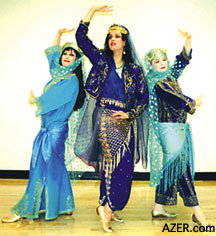  Left:
Maghrebi
(Maroccan) Princess of the Blue Dome portrayed by Anetta Burger,
flanked by handmaidens Sandra Litwin (left) and Cindy Connelly
Ryan (right) perform a serene piece inspired by a Sufi ritual. Left:
Maghrebi
(Maroccan) Princess of the Blue Dome portrayed by Anetta Burger,
flanked by handmaidens Sandra Litwin (left) and Cindy Connelly
Ryan (right) perform a serene piece inspired by a Sufi ritual.
More than 800
years after its creation, Nizami's literary masterpiece reaches
beyond the intervening centuries to inspire all of us, especially
the members of Silk Road Dance Company, who will bring the Seven
Beauties to life on stage.
The exquisite beauty of the dance, poetry, and music of the Islamic
world, reveals a different face than the austere fundamentalism
known to most Americans. Haft Paykar invokes love, color, words,
music, scent and taste to express deep mystical concepts. And
this is the genius of Nizami. Here, in the hidden gardens of
allegory, beauty that appeals to the senses becomes a way of
finding oneness with God.
Instead of falling prey to the false notion of a 'clash of civilizations,'
we need to remember that East and West have interacted for millennia,
often crossing cultures with positive results.
The story that frames the tale of the Seven Beauties - the education
of a ruler who has achieved great wealth and power, but is in
need of wisdom from other cultures - gives the medieval epic
an eerie immediacy. It is a tribute to Nizami's stature as a
world artist that he can still speak to our hearts from another
age, imparting wisdom that is so crucial in this present day.
Founder and
Artistic Director of the Silk Road Dance Company, Laurel Victoria
Gray is the recipient of the Kennedy Center 2003 Local Dance
Commissioning Project Award and the International Academy of
Middle Eastern Dance (IAMED) Awards for Best Choreographer (2003)
and Best Ethnic Dancer (1999). Gray's research has taken her
to five continents. Her articles have appeared in academic and
popular publications. In 1984, she founded the Uzbek Dance and
Culture Society (UZBEKDANCE.org). In 1994 she established
the annual Central Asian Dance Camp. Gray teaches dances of the
Islamic World as Adjunct Faculty at George Mason University and
George Washington University. LAURELVICTORIAGRAY.com. For activities related
to Seven Beauties, visit SILKROADDANCE.com.
Back to Index AI 13.1 (Spring
2005)
AI Home
| Search | Magazine
Choice
| Topics
| AI Store | Contact us
Other Web sites
created by Azerbaijan International
AZgallery.org | AZERI.org | HAJIBEYOV.com
|






